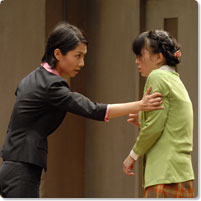Data
:
First Performance: 2006
Performance time: 2 hr.
Acts / Scenes: 1 act, 7 scenes
Cast: 6 (1 men, 5 women)
Yukiko Motoya
Distress Call — “Sounan, ”

Yukiko Motoya
Born in Ishikawa prefecture in 1979, Yukiko Motoya is a playwright and director. Today she leads the Gekidan, Motoya Yukiko theater company. After graduating from high school, Motoya acted in plays including Fukusuke by the company Otona Keikaku, altT4 supervised by Akio Miyazawa and 1989 by Village Produce. In September of 2000 she launched her own company. She has also become the object of increasing attention as a writer with her nomination for the 18th Mishima Yukio Award for the short novel version of her play Funukedomo, Kanashimi no Ai wo Misero (Cowards, Show Your Sad Love), and for the 135th Akutagawa Award for her short novel Ikiteiru dake de Ai (Love, from Just Being Alive).

The play is set in the teachers’ room of a middle school. It is actually a temporary teachers’ room the school has set up in a room of its old building in order to accommodate a certain problem. There, a student’s mother named Nishina is mercilessly grilling a teacher, Ms. Ekuni, with questions and accusations. She presses her claim that the recent attempted suicide of her son—who now lies in a coma—was the result of the fact that Ms. Ekuni ignored the pleas for help that her son was supposedly making.
As Ekuni’s fellow teachers, Fuha, Satomi and Ishihara listen to this, they also feel as if they are sitting on the same cushion of thorns. In its efforts to deal with this problem, the school has moved these four 8th grade teachers to this temporary teachers’ room and has become a convenient evacuation to minimize the damage of this incident.
Nishina threatens to find the letter that her son supposedly sent to his teacher asking for help and leak it to the media as a way to plead her case. Ekuni, for her part, expresses her concern for the Nishina family’s distress but claims that she never received such a letter. Taking the lead in defending Ekuni based on that claim is another teacher named Satomi known for her usually wise leadership.
Meanwhile, a strange series of stalker-like incidents have been occurring around the school. Someone has been cutting up the desk and school bag of a student named Ozaki with a sculpture knife and stealing things like her flute and gym suit. The male teacher Fuha leaves to go on his daily rounds in search of the “Ozaki criminal,” as they have labeled the stalker.
Eventually, the mother Nishina leaves and so does Ekuni, which leaves only Satomi and Ishihara in the room. Ishihara says to Satomi, “It was you who Nishina’s son sent the letter to, isn’t it? I’m going to tell everyone the truth.”
Ishihara had seen Satomi read the letter, tear it up and throw it away. She produces the letter, which she has taped back together, and she reads from it: “To Ms. Satomi. I am going to commit suicide because of what you have done to me.” Satomi later takes the letter from Ishihara’s desk drawer and is clearly distraught as she wonders what to do about the situation.
The next day, Ishihara is about to tell Ekuni and Fuha about the letter when she finds that it has been replaced by a fake one. At first Satomi pretends ignorance but eventually she begins to confess that she herself tried to commit suicide when she was a 14-year-old middle schooler. She goes on to say that as she lay in the hospital her teacher came and whispered in her ear, “You didn’t really intend to kill yourself, did you?”
Hearing this, Ekuni tries to console Satomi, saying, “That trauma must have kept you from ever talking about that to anyone, didn’t it?” She even suggests that she will say she got the letter in order to protect Satomi. Making skillful use of the word trauma, Satomi not only regains her strength but even goes on to begin controlling people and manipulating them like a devil.
In fact, Satomi was a compulsive liar since she was in middle school, soft on herself and saying injurious things to others. Blaming her nature on her middle school teacher, she would call her every time she got in trouble and accuse her by saying, “It’s your fault that I’m this way. It’s the trauma you gave me.” It even turns out that the “Ozaki criminal” was another of Satomi’s crazed creations, because she feared that the student Osaki had discovered her true nature and thus needed to find a way to keep her out of the school. In order to protect this fictional image of herself as a great teacher, Satomi finds out people’s secrets and uses them to her advantage. Where there are no secrets she creates false ones.
When Osaki, who had run away from home for a while, returns to school, however, the now distraught Satomi’s illusions begin again. Finally, she admits that her suicide attempt had been a pathetic show in which she jumped into the bushes from the second floor and that she had intentionally ignored the poor boy Nishina’s pleas for help.
But Satomi’s actions bring out darker sides of human relationships in a number of people, including Ekuni with her malice, the mother Nishina with her surprise at learning the truth, the revelation of the fact that she actually had abused her son, marital infidelity, etc. Seeing the bad sides of these other people revives Satomi’s spirit with the realization that they are all no-goods.
Having now been ridiculed by everyone for not really having experienced a trauma in her youth, Satomi tries to recover her identity as the traumatized girl by convincing everyone that she is indeed traumatized by trying to commit suicide. Almost as a replay middle-school days, she threatens to plunge to her death. Ishihara suggests that she try to erase her trauma by saying to the boy Nishina the words she had wanted to hear when she was in his position. Satomi resists, saying, “My twisted character is the result of trauma. So, don’t take my reason for being this way.” What is it that Satomi says when she is given a phone that has been connected to Nishina’s bedside in the hospital …? From somewhere comes the muffled sound of a snowstorm, the lighting turns blue and singles out Satomi, and at that very moment the stage blacks out.
Related Tags

